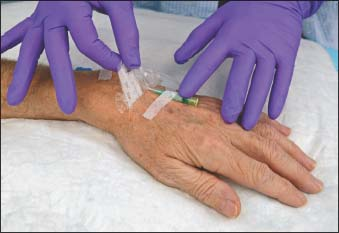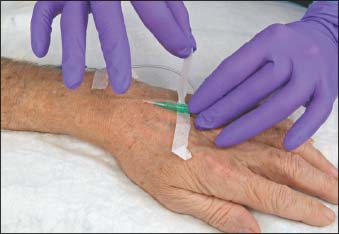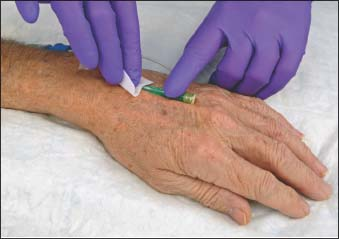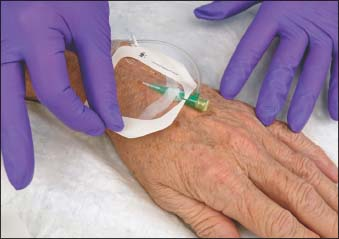IV Catheter Maintenance
Routine maintenance of an IV site includes regular assessment of the site and periodic changes of the dressing, along with solution changes, and regular tubing changes, which help prevent complications, such as thrombophlebitis and infection. They should be performed according to your facility’s policy.
Routine site care and IV dressing changes aren’t recommended for short peripheral IV catheters unless the dressing becomes soiled or damp or is no longer intact.1,2 Dressings are also changed when the device is changed; the IV catheter should be changed when clinically indicated by the patient’s condition, integrity of the vein
and skin, length and type of prescribed therapy, integrity and patency of the existing catheter, and the patient’s care location.2 Peripheral IV catheters should be replaced no more frequently than every 72 to 96 hours to reduce the risk for infection and phlebitis in adults;1 follow your facility’s policy for IV maintenance. If an IV catheter is inserted during an emergency, it should be replaced as soon as possible, within 48 hours.2
and skin, length and type of prescribed therapy, integrity and patency of the existing catheter, and the patient’s care location.2 Peripheral IV catheters should be replaced no more frequently than every 72 to 96 hours to reduce the risk for infection and phlebitis in adults;1 follow your facility’s policy for IV maintenance. If an IV catheter is inserted during an emergency, it should be replaced as soon as possible, within 48 hours.2
The IV administration set should be changed no more frequently than every 96 hours, although it should be changed immediately upon suspected contamination, when the integrity of the product or system has been compromised, or whenever the peripheral IV site is rotated.1,3
Another aspect of IV catheter maintenance, ensuring an accurate flow rate helps prevent complications. Calculated from a doctor’s order, flow rate is usually expressed as the total volume of IV solution infused over a prescribed interval or as the total volume given in milliliters per hour. Many devices can regulate the flow of IV solution, including clamps, the flow regulator (or rate minder), and the volumetric pump. With any device, flow rate can be easily monitored by using a time tape, which indicates the prescribed solution level at hourly intervals. IV time tapes are rarely used in acute care settings, but may be found in long-term or subacute care settings.
Equipment
For A Dressing Change
Gloves ▪ antiseptic solution ▪ transparent semipermeable dressing ▪ catheter securement device, sterile tape, or sterile surgical strips ▪ label ▪ Optional: sterile 2″ × 2″ gauze pad and adhesive bandage, as needed.
For A Solution Change
Solution container ▪ antiseptic pad (alcohol, tincture of iodine, or chlorhexidine-based) ▪ gloves.
For an IV Tubing Change
IV administration set ▪ new bag of prescribed IV fluids (as needed) ▪ gloves ▪ transparent semipermeable dressing ▪ sterile 2″ × 2″ gauze pads ▪ label.
For Using A Time Tape
IV solution ▪ IV administration set with clamp ▪ 1″ paper or adhesive tape (or preprinted time tape) ▪ pen.
Preparation of Equipment
If your facility keeps IV equipment and dressings in a tray or cart, have it nearby, if possible, because you may have to select a new venipuncture site, depending on the current site’s condition.
When possible, change the solution and tubing at the same time to decrease the risk of contamination.3
If you’re changing both the solution and the tubing, attach and prime the IV administration set, including add-on devices, before entering the patient’s room.
Implementation
Verify the doctor’s order.
Confirm the patient’s identity using at least two patient identifiers according to your facility’s policy.8
Explain the procedure to the patient to allay his fears and ensure cooperation.
Changing A Dressing
Open all supply packages.
Put on gloves.
Remove the old dressing (as shown below).

Hold the cannula in place with your nondominant hand to prevent accidental movement or dislodgment, which could puncture the vein and cause infiltration (as shown below).

Assess the venipuncture site for signs of infection (redness and pain at the puncture site), infiltration (coolness, blanching, and edema at the site), and thrombophlebitis (redness, firmness, tenderness, warmth, palpable venous cord, and edema).1 If any such signs are present, cover the area with a sterile 2″ × 2″ gauze pad and remove the catheter. Apply pressure to the area until the bleeding stops, and apply an adhesive bandage. Then, using fresh equipment and solution, start the IV in another appropriate site, preferably on the opposite extremity.
If the venipuncture site is intact, stabilize the cannula and carefully clean around the puncture site with antiseptic solution (as shown below). Cleaning methods vary with the type of antiseptic used. Apply chlorhexidine using a side-to-side motion for at least 30 seconds.9 Allow the area to dry completely.

Secure the catheter with a catheter securement device, sterile tape, or sterile surgical strips.9
Cover the site with a transparent semipermeable dressing.9 The transparent dressing allows visualization of the insertion site and maintains sterility. Place it over the insertion site to halfway up the cannula (as shown below).

Label the dressing with the date and time of the procedure.2
Discard used supplies in the appropriate receptacle.

Stay updated, free articles. Join our Telegram channel

Full access? Get Clinical Tree


Get Clinical Tree app for offline access
